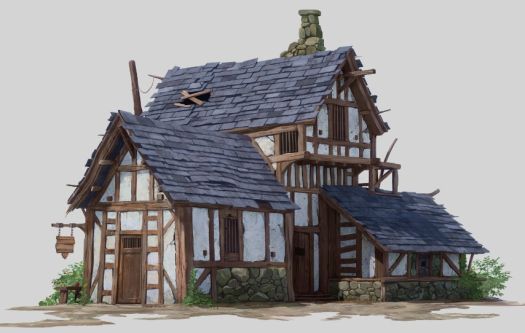Difference between revisions of "Half-timbered House (dwelling)"
Tao alexis (talk | contribs) |
Tao alexis (talk | contribs) |
||
| Line 1: | Line 1: | ||
[[File:Half-timbered House.jpg|right|525px|thumb|Roofing was more commonly thatch in rural areas, though the shingled house was common inside larger [[Town|towns]] and [[City|cities]]]] | [[File:Half-timbered House.jpg|right|525px|thumb|Roofing was more commonly thatch in rural areas, though the shingled house was common inside larger [[Town|towns]] and [[City|cities]]]] | ||
| − | '''Half-timbered houses''' are buildings constructed with cylindrical logs hewed in half with broadaxe and adze. The cut log is shaved to smoothness and exposed to the outside, with the rounded wooden bark forming the interior walls. Spaces between the logs are filled with daub to produce a smooth interior finish, with edges or even none of the timber showing | + | '''Half-timbered houses''' are buildings constructed with cylindrical logs hewed in half with broadaxe and adze. The cut log is shaved to smoothness and exposed to the outside, with the rounded wooden bark forming the interior walls. Spaces between the logs are filled with daub to produce a smooth interior finish, with edges or even none of the timber showing. |
__TOC__ | __TOC__ | ||
| + | Alternately, the timbers are used to create "panels," as shown in the accompanying image, which are then filled-in with some kind of nonstructural material, contained by wattle. Daub is also used to cover this wattle to produce the flat surface shown in the image. The timbers were often left exposed and painted to distinguish them, producing a familiar early Renaissance-appearance. | ||
| + | |||
Even small, crude half-timbered houses are fairly expensive to build compared to [[Hovel (dwelling)|hovels]]. Thus, in [[Hamlet|hamlets]], they're available only to the artisan class: [[Bakery|bakers]], [[Gristmill|millers]], [[Granary|granary]] owners and [[Way Station|way station]] holders. Wealthy [[Freeholder|freeholders]] who control two or more [[Measurements#Land|virgates]] of land may own a half-timbered house. | Even small, crude half-timbered houses are fairly expensive to build compared to [[Hovel (dwelling)|hovels]]. Thus, in [[Hamlet|hamlets]], they're available only to the artisan class: [[Bakery|bakers]], [[Gristmill|millers]], [[Granary|granary]] owners and [[Way Station|way station]] holders. Wealthy [[Freeholder|freeholders]] who control two or more [[Measurements#Land|virgates]] of land may own a half-timbered house. | ||
== Construction == | == Construction == | ||
Revision as of 00:16, 2 January 2023
Half-timbered houses are buildings constructed with cylindrical logs hewed in half with broadaxe and adze. The cut log is shaved to smoothness and exposed to the outside, with the rounded wooden bark forming the interior walls. Spaces between the logs are filled with daub to produce a smooth interior finish, with edges or even none of the timber showing.
Contents
Alternately, the timbers are used to create "panels," as shown in the accompanying image, which are then filled-in with some kind of nonstructural material, contained by wattle. Daub is also used to cover this wattle to produce the flat surface shown in the image. The timbers were often left exposed and painted to distinguish them, producing a familiar early Renaissance-appearance.
Even small, crude half-timbered houses are fairly expensive to build compared to hovels. Thus, in hamlets, they're available only to the artisan class: bakers, millers, granary owners and way station holders. Wealthy freeholders who control two or more virgates of land may own a half-timbered house.
